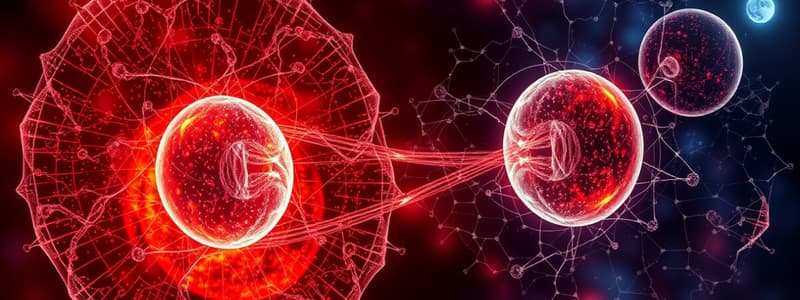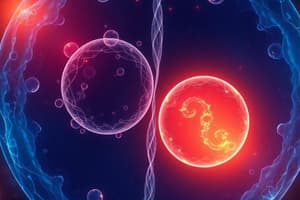Podcast
Questions and Answers
What is the primary purpose of meiosis in organisms?
What is the primary purpose of meiosis in organisms?
- Genetic variation through sexual reproduction (correct)
- Production of somatic cells
- Asexual reproduction
- Growth and repair of tissues
Which of the following correctly describes the outcome of mitosis?
Which of the following correctly describes the outcome of mitosis?
- Four haploid daughter cells
- Two haploid daughter cells
- Two genetically identical daughter cells with a diploid number (correct)
- Four genetically distinct daughter cells
During which phase of meiosis do homologous chromosomes pair up and exchange genetic material?
During which phase of meiosis do homologous chromosomes pair up and exchange genetic material?
- Metaphase I
- Anaphase II
- Telophase I
- Prophase I (correct)
How many divisions occur during meiosis?
How many divisions occur during meiosis?
What event occurs during Anaphase I of meiosis?
What event occurs during Anaphase I of meiosis?
Which stage of meiosis involves the reformation of the nuclear envelope?
Which stage of meiosis involves the reformation of the nuclear envelope?
What happens during the Pachytene phase of Prophase I?
What happens during the Pachytene phase of Prophase I?
Which type of cells undergoes meiosis?
Which type of cells undergoes meiosis?
What is the significance of the polar body formed during meiosis I in oogenesis?
What is the significance of the polar body formed during meiosis I in oogenesis?
During which part of oogenesis does the secondary oocyte undergo a second pause?
During which part of oogenesis does the secondary oocyte undergo a second pause?
How does estrogen influence gametogenesis and secondary sexual development?
How does estrogen influence gametogenesis and secondary sexual development?
What occurs immediately after the secondary oocyte is fertilized by a sperm?
What occurs immediately after the secondary oocyte is fertilized by a sperm?
Which phase marks the initiation of oogenesis correlating with changes in secondary sexual development during puberty?
Which phase marks the initiation of oogenesis correlating with changes in secondary sexual development during puberty?
What is the outcome of telophase II in meiosis?
What is the outcome of telophase II in meiosis?
What occurs during interkinesis following meiosis I?
What occurs during interkinesis following meiosis I?
Which is a consequence of errors during metaphase I in meiosis?
Which is a consequence of errors during metaphase I in meiosis?
What is a potential outcome of non-disjunction during anaphase I?
What is a potential outcome of non-disjunction during anaphase I?
What phase do primary oocytes remain arrested until puberty?
What phase do primary oocytes remain arrested until puberty?
How does interkinesis differ from cytokinesis during mitosis?
How does interkinesis differ from cytokinesis during mitosis?
What consequence can arise from errors in telophase I or interkinesis?
What consequence can arise from errors in telophase I or interkinesis?
What is one significant biological role of interkinesis in meiosis?
What is one significant biological role of interkinesis in meiosis?
Which of the following misalignments would lead a cell to stall during the metaphase I checkpoint?
Which of the following misalignments would lead a cell to stall during the metaphase I checkpoint?
During which stage of meiosis can non-disjunction primarily occur?
During which stage of meiosis can non-disjunction primarily occur?
What kind of cells are produced at the end of oogenesis?
What kind of cells are produced at the end of oogenesis?
In which phase do errors related to spindle formation primarily have consequences?
In which phase do errors related to spindle formation primarily have consequences?
What is the primary function of checkpoints in the cell cycle during meiosis?
What is the primary function of checkpoints in the cell cycle during meiosis?
What is the primary significance of crossing over during meiosis?
What is the primary significance of crossing over during meiosis?
Which statement best describes the role of the synaptonemal complex during diplotene?
Which statement best describes the role of the synaptonemal complex during diplotene?
What occurs during diakinesis that differs from prophase I?
What occurs during diakinesis that differs from prophase I?
How does the genetic variation produced by meiosis contrast with that of mitosis?
How does the genetic variation produced by meiosis contrast with that of mitosis?
What is the chromosome content of daughter cells after mitosis in humans?
What is the chromosome content of daughter cells after mitosis in humans?
Which of the following statements accurately describes interkinesis?
Which of the following statements accurately describes interkinesis?
What distinguishes meiosis II from mitosis?
What distinguishes meiosis II from mitosis?
Which process does not occur during interkinesis?
Which process does not occur during interkinesis?
What effect does crossing over have on homologous chromosomes?
What effect does crossing over have on homologous chromosomes?
Which stage of meiosis is primarily responsible for reducing the chromosome number?
Which stage of meiosis is primarily responsible for reducing the chromosome number?
What is a significant difference in purpose between meiosis and mitosis?
What is a significant difference in purpose between meiosis and mitosis?
In what way does cytokinesis differ from interkinesis?
In what way does cytokinesis differ from interkinesis?
Flashcards are hidden until you start studying
Study Notes
Mitosis vs. Meiosis Overview
- Mitosis serves growth, repair, and asexual reproduction, yielding two genetically identical diploid daughter cells.
- Meiosis facilitates sexual reproduction, producing four genetically distinct haploid daughter cells to enhance genetic diversity.
Sequential Phases of Meiosis
-
Meiosis I:
- Prophase I: Homologous chromosomes pair (synapsis) and exchange genetic material (crossing over) while the nuclear envelope breaks down.
- Metaphase I: Homologous chromosomes align at the metaphase plate, spindle fibers attach, and chromatid separation is not activated.
- Anaphase I: Homologous chromosomes are pulled to opposite poles of the cell.
- Telophase I: Chromosomes reach poles, decondense, and cytokinesis results in two haploid cells.
-
Meiosis II:
- Prophase II: Chromosomes condense in haploid daughter cells, and spindle formation occurs.
- Metaphase II: Chromosomes align at the plate; spindle fibers attach to centromeres.
- Anaphase II: Sister chromatids separate and move to opposite poles.
- Telophase II: Chromatids decondense, and the nuclear envelope reforms; cytokinesis produces four genetically distinct haploid daughter cells.
Subphases of Prophase I
- Leptotene: Chromosomes condense and become visible.
- Zygotene: Synapsis occurs, forming tetrads via the synaptonemal complex.
- Pachytene: Crossing over occurs, enhancing genetic diversity.
- Diplotene: Synaptonemal complex begins disassembly; chromosomes remain connected at chiasmata.
- Diakinesis: Maximum chromosome condensation, nuclear envelope breakdown, and chiasmata terminalization prepare for segregation.
Differences Between Mitosis and Meiosis
- Divisions: Mitosis has one division, meiosis has two.
- Daughter Cells: Mitosis yields two daughter cells; meiosis produces four.
- Genetic Variation: Mitosis produces identical cells; meiosis results in genetic diversity.
- Chromosome Number: Mitosis maintains diploid number; meiosis reduces it by half (haploid).
- Purpose: Mitosis is for growth and repair, while meiosis drives sexual reproduction and evolution.
- Synapsis: Occurs in meiosis only, promoting genetic recombination.
Chromosome Content After Division
- Mitosis: Each daughter cell retails the diploid chromosome number (2n), e.g., 46 chromosomes in humans.
- Meiosis: Each gamete has half the chromosome number (haploid, n), e.g., 23 chromosomes in humans.
Processes Influencing Chromosome Content Changes
-
Mitosis:
- Involves a single division after DNA replication; chromatids are separated during anaphase to ensure identical sets.
-
Meiosis:
- Features two divisions (Meiosis I and II) following a single replication cycle. Reduction occurs in Meiosis I, separating homologous chromosomes.
Interkinesis Explained
- Interkinesis is an intermediate phase between meiosis I and II, shorter than interphase and lacking DNA replication.
- Prepares cells for the second meiotic division, occasionally involving nuclear envelope reformation and chromosome decondensation.
Consequences of Errors in Mitosis and Meiosis
- Meiosis Errors:
- Prophase I Errors: Induce non-disjunction; may cause Down syndrome or miscarriages, stalling during pachytene if pairing fails.
- Metaphase I Errors: Incorrect alignment leads to missing/extra chromosomes; stalling at the metaphase checkpoint.
- Anaphase I Errors: Failed homolog separation results in aneuploidy; cells may stall or proceed incorrectly.
- Telophase I/Interkinesis Errors: Failures can cause incorrect chromosomal content in meiosis II.
- Meiosis II Errors: Spindle formation or separation errors lead to defective gametes.
Oogenesis Overview
- Oogenesis produces female gametes (ova) in the ovaries, involving multiple stages with critical pauses during meiosis.
Steps in Oogenesis
-
Fetal Development:
- Primordial germ cells migrate to ovaries, developing into diploid oogonia, which form primary oocytes that arrest in prophase I.
-
Puberty to Menopause:
- Primary oocytes complete meiosis I, creating secondary oocyte and polar body, which degenerates.
- Secondary oocyte halts in metaphase II until fertilization; upon fertilization, meiosis II concludes, forming a mature ovum.
Connection with Secondary Sexual Development
- Primary oocyte formation occurs before birth; re-initiation of oogenesis at puberty coincides with menstrual cycle and secondary sexual characteristic development.
- Follicular maturation induces estrogen production, triggering secondary sexual development.
Studying That Suits You
Use AI to generate personalized quizzes and flashcards to suit your learning preferences.





